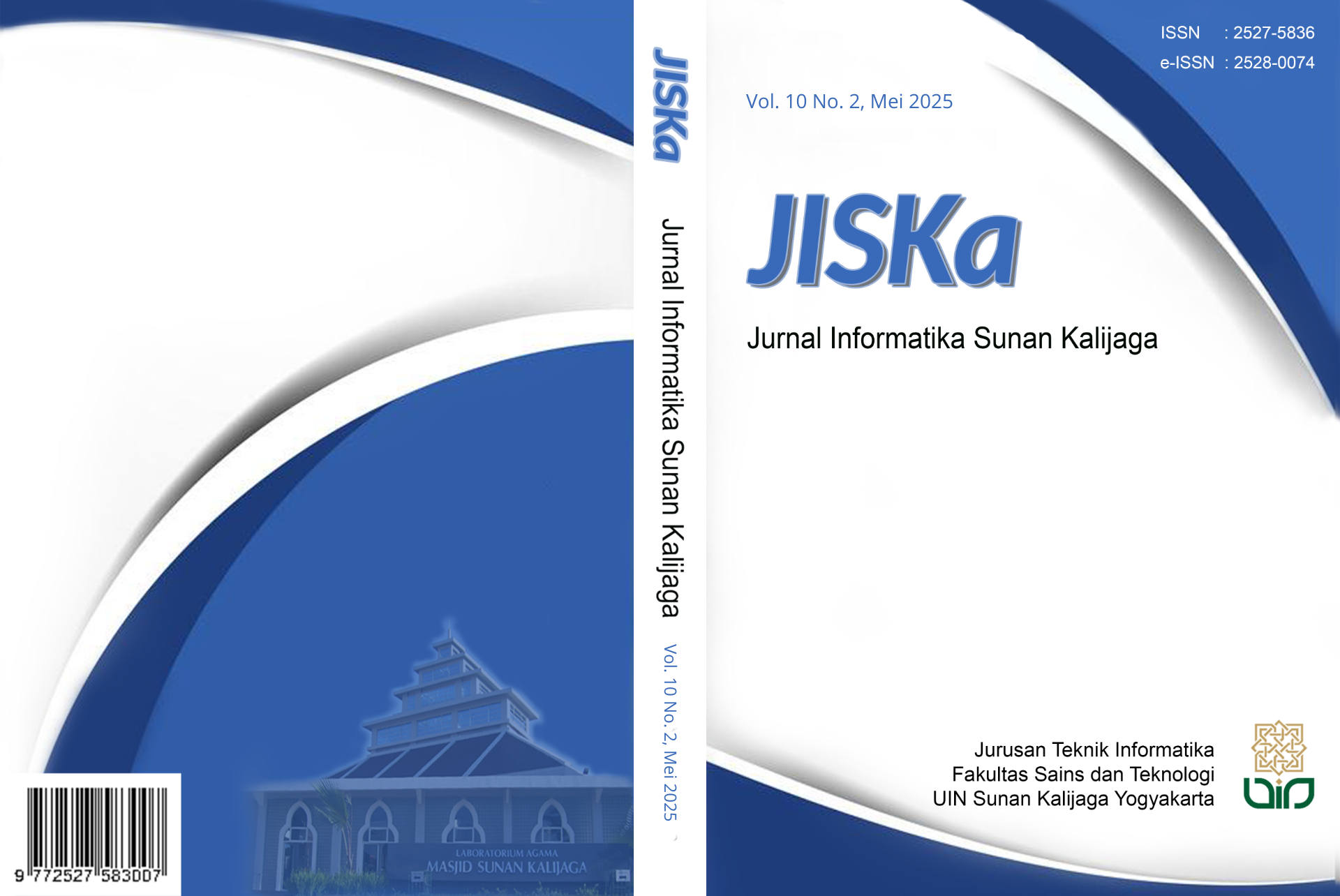Perbandingan Random Forest dan Convolutional Neural Network dalam Memprediksi Peralihan Pelanggan
DOI:
https://doi.org/10.14421/jiska.2025.10.2.186-194Keywords:
CNN, Customer Churn, Data Mining, Prediction, Random ForestAbstract
The rapid growth of the telecommunications industry has increased competition among companies for customers. As a result, customers often switch services or terminate subscriptions. Retaining customers is very important as it is 10 times cheaper than acquiring new customers. This study compares Random Forest (RF) and Convolutional Neural Network (CNN) algorithms in predicting customer switching, using Correlation-based Feature Selection (CFS) and Recursive Feature Elimination (RFE) for data partitioning. Model evaluation using Confusion Matrix and Area Under Curve (AUC). The evaluation results show that the performance of CNN models with optimization parameters is superior. Using the CFS dataset, the test data evaluation results obtained an accuracy of 98%, AUC 0,96, precision 99%, recall 92%, and f1-score 96%. The best tuning result for CNN is 3 combinations of filter and kernel {[64&7], [32&3], [16&2]} and pool_size=2. The limitation of this research is how to handle the two algorithms being compared. Both use different approaches, namely Supervised Learning and Deep Learning.
References
AL-Najjar, D., Al-Rousan, N., & AL-Najjar, H. (2022). Machine Learning to Develop Credit Card Customer Churn Prediction. Journal of Theoretical and Applied Electronic Commerce Research, 17(4), 1529–1542. https://doi.org/10.3390/jtaer17040077
Li, A., Yang, T., Zhan, X., Shi, Y., & Li, H. (2024). Utilizing Data Science and AI for Customer Churn Prediction in Marketing. Journal of Theory and Practice of Engineering Science, 4(05), 72–79. https://doi.org/10.53469/jtpes.2024.04(05).10
de Lima Lemos, R. A., Silva, T. C., & Tabak, B. M. (2022). Propension to Customer Churn in a Financial Institution: A Machine Learning Approach. Neural Computing and Applications, 34(14), 11751–11768. https://doi.org/10.1007/s00521-022-07067-x
Gabhane, M. D., Suriya, A., & Kishor, S. B. (2022). Churn Prediction in Telecommunication Business Using CNN and ANN. Journal of Positive School Psychology, 2022(4), 4672–4680. https://journalppw.com/index.php/jpsp/article/view/4158
Husein, A. M., & Harahap, M. (2021). Pendekatan Data Science untuk Menemukan Churn Pelanggan pada Sector Perbankan dengan Machine Learning. Data Sciences Indonesia (DSI), 1(1), 8–13. https://doi.org/10.47709/dsi.v1i1.1169
Lalwani, P., Mishra, M. K., Chadha, J. S., & Sethi, P. (2022). Customer Churn Prediction System: A Machine Learning Approach. Computing, 104(2), 271–294. https://doi.org/10.1007/s00607-021-00908-y
Mawaddah, U., Armanto, H., & Setyati, E. (2021). Prediksi Karakteristik Personal Menggunakan Analisis Tanda Tangan dengan Mengggunakan Metode Convolutional Neural Network (CNN). Antivirus : Jurnal Ilmiah Teknik Informatika, 15(1), 123–133. https://doi.org/10.35457/antivirus.v15i1.1526
Muthmainah, & Cholil, M. (2022). Faktor yang Mempegaruhi Perilaku Peralihan Pelanggan: Peran Mediasi Kepuasan dan Kepercayaan Pelanggan. Jurnal Riset Bisnis dan Investasi, 7(3), 125–136. https://doi.org/10.35313/jrbi.v7i3.3437
Ojo, A. K. (2024). Predicting Customer Churn in Telecommunication Industry Using Convolutional Neural Network Model. SSRN Electronic Journal, 22(3), 54–59. https://doi.org/10.2139/ssrn.4983685
Rahman, M., & Kumar, V. (2020). Machine Learning Based Customer Churn Prediction in Banking. 2020 4th International Conference on Electronics, Communication and Aerospace Technology (ICECA), 1196–1201. https://doi.org/10.1109/ICECA49313.2020.9297529
Sandag, G. A. (2020). Prediksi Rating Aplikasi App Store Menggunakan Algoritma Random Forest. CogITo Smart Journal, 6(2), 167–178. https://doi.org/10.31154/cogito.v6i2.270.167-178
Saputro, I. W., & Sari, B. W. (2020). Uji Performa Algoritma Naïve Bayes untuk Prediksi Masa Studi Mahasiswa. Creative Information Technology Journal, 6(1), 1. https://doi.org/10.24076/citec.2019v6i1.178
Singh, U., Rizwan, M., Alaraj, M., & Alsaidan, I. (2021). A Machine Learning-Based Gradient Boosting Regression Approach for Wind Power Production Forecasting: A Step towards Smart Grid Environments. Energies, 14(16), 5196. https://doi.org/10.3390/en14165196
Suryana, N., Pratiwi, P., & Prasetio, R. T. (2021). Penanganan Ketidakseimbangan Data pada Prediksi Customer Churn Menggunakan Kombinasi SMOTE dan Boosting. IJCIT (Indonesian Journal on Computer and Information Technology), 6(1), 31–37. https://doi.org/10.31294/ijcit.v6i1.9545
Wicaksono, A., Anita, A., & Padilah, T. N. (2021). Uji Performa Teknik Klasifikasi untuk Memprediksi Customer Churn. Bianglala Informatika, 9(1), 37–45. https://doi.org/10.31294/bi.v9i1.9992
Yahaya, R., Abisoye, O. A., & Bashir, S. A. (2021). An Enhanced Bank Customers Churn Prediction Model Using a Hybrid Genetic Algorithm and K-Means Filter and Artificial Neural Network. 2020 IEEE 2nd International Conference on Cyberspac (CYBER NIGERIA), 52–58. https://doi.org/10.1109/CYBERNIGERIA51635.2021.9428805
Downloads
Published
How to Cite
Issue
Section
License
Copyright (c) 2025 Dewa Adji Kusuma, Atika Ratna Dewi, Andreas Rony Wijaya

This work is licensed under a Creative Commons Attribution-NonCommercial 4.0 International License.
Authors who publish with this journal agree to the following terms as stated in http://creativecommons.org/licenses/by-nc/4.0
a. Authors retain copyright and grant the journal right of first publication with the work simultaneously licensed under a Creative Commons Attribution License that allows others to share the work with an acknowledgement of the work's authorship and initial publication in this journal.
b. Authors are able to enter into separate, additional contractual arrangements for the non-exclusive distribution of the journal's published version of the work (e.g., post it to an institutional repository or publish it in a book), with an acknowledgement of its initial publication in this journal.
c. Authors are permitted and encouraged to post their work online (e.g., in institutional repositories or on their website) prior to and during the submission process, as it can lead to productive exchanges, as well as earlier and greater citation of published work.










